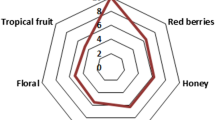Abstract
The aroma of Rhine Riesling must and wine was studied to determine the most intense odor-active compounds. The study was carried out using a special designed method of gas chromatography-olfactometry (GCO) to detect characteristic odorants, which were identified by GC-MS. Generally, the obtained results showed higher odor intensities for the wine than for the must samples. The aroma substances 2-phenylethanol, 3-methyl-1-butanol, 3-(methylthio)-1-propanol, ethyl propanoate, ethyl butanoate, ethyl 3-methylbutanoate, 3-methyl-1-butanol acetate, ethyl hexanoate, ethyl octanoate, ethyl 3-hydroxybutanoate, 2-phenylethyl acetate, hexanoic acid, 3-methylbutanoic acid, butanoic acid, β-damascenone, γ-undecalactone and 4-vinylguaiacol were detected as the most active odorants in the Rhine Riesling wine. The aroma of Rhine Riesling must was characterized by 2-ethyl-1-hexanol, (E)-2-penten-1-ol, 1-terpinen-4-ol, benzyl alcohol, 2-phenylethanol, α-terpineol, d-limonene, β-damascenone, 3-methylbutanoic acid and benzeneacetaldehyde.


Similar content being viewed by others
References
Yegge JM, Noble AC (2001) Proceedings of the American Society of Enology and Viticulture, 50th Anniversary Annual Meeting, Seattle, WA. Am J Enol Vitic (special edition), 28–31
Rapp A (1998) Volatile flavour of wine: correlation between instrumental analysis and sensory perception. Nahrung 42:351–363
Marti MP, Mestres M, Sala C, Busto O, Guasch J (2003) Solid-phase microextraction and gas-chromatography olfactometry analysis of successively diluted samples. A new approach of the aroma extract dilution analysis applied to the characterization of wine aroma. J Agric Food Chem 51:7861–7865
Amerine MA, Roessler EB (1983) Wines, Their Sensory Evaluation, 2nd edn. Freeman, W. H. and Company, New York, pp 99–109
Chisholm MG, Guiher LA, Vonah TM, Beaumont JL (1994) Comparison of some French-American hybrid wines with White Riesling using gas chromatography-olfactometry. Am J Enol Vitic 45(2):201–212
Schlich P, Moio L (1994) Correlation between flavour profiles and aromagrams of Chardonnay Burgundy wines. Sci Aliments 14:609–615
Moio L, Schlich P, Etievant P (1994) Acquitision and analysis of aromagrams of Chardonnay Burgundy wines. Sci Aliments 14:601–608
Valim MF, Rouseff RL, Lin J (2003) Gas chromatographic-olfactometry characterization of aroma compounds in two types of Cashew Apple Nectar. J Agric Food Chem 51:1010–1015
Lee S, Noble AC (2003) Characterization of odor-active compounds in Californian Chardonnay wines using GC-olfactometry and GC-mass spectrometry. J Agric Food Chem 51:8036–8044
Lopez R, Ortin N, Perez-Trujillo JP, Cacho J, Ferreira V (2003) Impact odorants of different young white wines from the Canary Islands. J Agric Food Chem 51(11):3419–3425
Deibler KD, Llesca FM, Lavin EH, Acree TE (2004) Calibration of gas chromatography inlet splitting for gas chromatography olfactometry dilution analysis. Flavour Fragr J 19(6):518–521
Guth H (1997) Identification of character impact odorants of different white wine variesties. J Agric Food Chem 45:3022–3026
Rapp A, Hastrich H, Engel H (1976) Gas-chromatographic investigations on the aroma constituents of grape. Concentration and separation by capillary glass columns. Vitis 15:29–36
Pollien P, Ott A, Montigon F, Baumgartner M, Munoz-Box R, Chaintreau A (1997) Hyphenated-gaschromatography-sniffing technique: screening of impact odorants and quantitative aromagrams comparison. J Agric Food Chem 45:2630–2637
Wijaya H, Ulrich D, Lestari R, Schippel K, Ebert G (2005) Identification of potent odorants in different cultivars of snake fruit [Salacca zalacca (Gaert.) voss] using gas chromatography-olfactometry. J Agric Food Chem 53:1637–1641
Chisholm MG, Guiher LA, Zaczkiewicz SM (1995) Aroma characteristics of aged vidal blanc wine. Am J Enol Vitic 46(1):56–62
Winterhalter P, Sefton MA, Williams PJ (1990) Two-dimensional GC-DCCC analysis of the glycoconjugates of monoterpenes, norisoprenoids and shikimate-derived metabolites from Riesling wine. J Agric Food Chem 38:1041–1048
Demyttenaere JCR, Dagher C, Sandra P, Kallithraka S, Verhe R, De Kimpe N (2003) Flavour analysis of Greek white wine by solid-phase microextraction-capillary gas chromatography-mass spectrometry. J Chromatogr A 985:233–246
Rapp A, Güntert M, Ullemeyer H (1985) Über Veränderungen der Aromastoffe während der Flaschenlagerung von Weiβweinen der Rebsort Riesling. Z. Lebensm. Unters Forsch 180:109–116
Zhou P, Braell PA, Acree TE (1986) Use of thin layer chromatography to design a liquid chromatographic separation scheme for β-damascenone precursors in grapes. In: Chemical separation, vol. I: principles. Litarvan Literature, Denver, pp 105–112
Hernandez-Orte P, Cacho JF, Ferreira V (2002) Relationship between varietal amino acid profile of grapes and wine aromatic composition. Experiments with model solution and chemometric study. J Agric Food Chem 50:2891–2899
Acknowledgment
We aknowledge the German Academic Exchange Service (DAAD) Bonn, Germany for providing a short-term visiting grant under which this work was completed. We also thank Dr. Schulz, the head of the Institute of Plant Analysis, BAZ, Germany for helpful discussions and Ms. Diessner for technical assistance.
Author information
Authors and Affiliations
Corresponding author
Rights and permissions
About this article
Cite this article
Komes, D., Ulrich, D. & Lovric, T. Characterization of odor-active compounds in Croatian Rhine Riesling wine, subregion Zagorje. Eur Food Res Technol 222, 1–7 (2006). https://doi.org/10.1007/s00217-005-0094-y
Received:
Revised:
Accepted:
Published:
Issue Date:
DOI: https://doi.org/10.1007/s00217-005-0094-y




